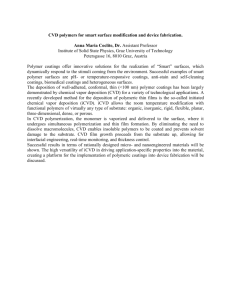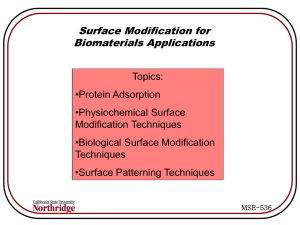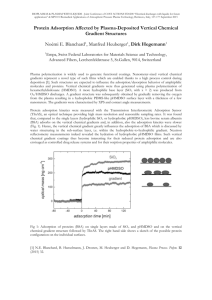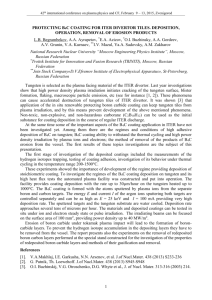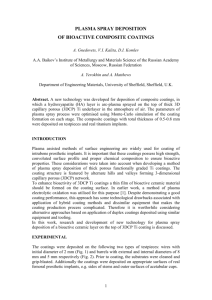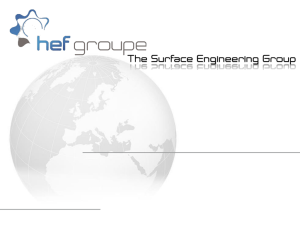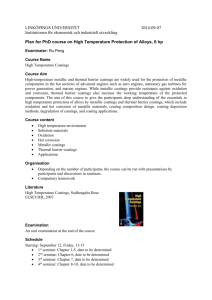슬라이드 1
advertisement
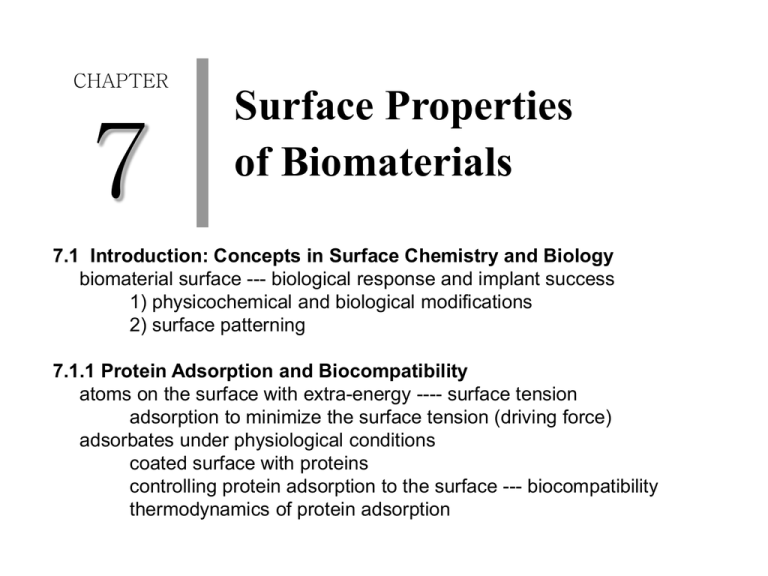
CHAPTER 7 Surface Properties of Biomaterials 7.1 Introduction: Concepts in Surface Chemistry and Biology biomaterial surface --- biological response and implant success 1) physicochemical and biological modifications 2) surface patterning 7.1.1 Protein Adsorption and Biocompatibility atoms on the surface with extra-energy ---- surface tension adsorption to minimize the surface tension (driving force) adsorbates under physiological conditions coated surface with proteins controlling protein adsorption to the surface --- biocompatibility thermodynamics of protein adsorption 7.1.2 Surface Properties Governing Protein Adsorption (1) Surface hydrophobicity contact angle analysis polymers > metals & ceramics hydrophobicity --- protein adsorption (2) Surface charge charge interaction with proteins (3) Physical characteristics of the surface steric concerns (hindrance & roughness) 1) large, hydrophilic polymers --- adsorption 감소 (quick movement & bulky chain) 2) roughness --- adsorption 증가 (physical trapping) Surface modifications --- Biocompatibility 7.2 Physicochemical Surface Modification Techniques 7.2.1 Introduction to Surface Modification Techniques post-fabrication vs. pre-designed ideal tech. 1) thin 2) resistant to delamination 3) simple & robust 4) discourage surface rearrangement Physicochemcial & Biological Modifications 7.2.2 Physicochemcial Surface Coatings: Covalent Surface Coatings (1) Plasma treatment plasma: assembly of species in an atomically/molecularly dissociated gaseous environment electric potential across a gas between cathode (-) and anode (+) electrons from cathode (sample) to anode positive ions to the sample on cathode 1) at the surface competition between deposition and ablation/etching very energetic species: etching deposition (free radicals or small molecules) 2) plasma discharge for surface pre-treatment cleaning or addition of –OH or –NH2 groups X-linking the copolymer on the surface [advantages] 1) conformal; 2) free of voids/pinhole defects; 3) easily prepared; 4) sterile; 5) low amount of leachable substances; 6) good adhesion; 7) unique film chemistry; 8) easy characterization [polymeric, metallic, and pyrolytic carbon-based materials] [disadvantages] 1) ill-defined chemistry; 2) expensive equipment; 3) difficult uniform reaction; 4) contamination cf) plasma torch plasma spray coatings [ceramic coatings to metallic implants] (2) Chemical vapor deposition (CVD) mix of gases – high temp – decomposition of one/more components of the gas --- substrate deposition plasma assisted chemical vapor deposition pyrolytic carbon coatings on substrates [tantalum, molybdenum/rhenium, graphite] (3) Physical vapor deposition (PVD) sputtering 1) energetic ions or atoms --- target bombardment --ejection of target surface atoms 2) target atoms --- sample surface --- thin film formation via condensation plasma-assisted PVD target (-) & sample (+) (4) Radiation grafting/photografting radiation on the surface --- reactive species --- covalent coating on the underlying material ex) hydrogel to hydrophobic substrates 1) mutual irradiation a) biomaterial substrate in monomer solution b) substrate irradiation first – then coating 2) radiation grafting in air ROS generation --- heating ---- polymerization 3) photografting with photoresponsive chemical moiety [phenyl azide, benzophenone] (5) Self-assembled monolayers (SAMs) Amphiphilic molecules a) attachment group; b) long hydrocarbon (alkyl) chain; 3) functional (polar) head group 1) strong exothermic reaction between substrate and attachment group 2) alkyl chains van der Waals force --- crystallization high molecular mobility --- tight packing [advantages of SAM] 1) easy formation; 2) chemical stability; 3) variety of chemical moieties 4) physical property control (smooth surface) 7.2.3 Physicochemical Surface Coating: Noncovalent Surface Coating (1) Solution coating dipping (polymer in organic solvent) --- dry --- polymer deposition cf) bioactive molecule coating in aqueous solvent (2) Langmuir-Blodgett films amphipathic molecules in Langmuir trough compression to critical area [constant minimum value of the area per molecule] size and type of hydrophobic tail [advantages] 1) uniformity; 2) chemical alteration [disadvantage] 1) instability [X-linking] (3) Surface-modifying additives (SMA) atoms and molecules in the material bulk spontaneously rise to the surface to reduce the surface free energy surface coating 1) difference in surface tension with and without the SMA 2) mobility of SMA; 3) surrounding environment (air, water) not post-fabrication, but a part of the formation/synthesis of the biomaterials metal; ceramics polymers Block copolymer A: anchor [bulk polymer interaction] B: surface property [incompatible with the bulk] [surface affinity] SMA coating: final environment 고려 ex) hydrophobic group 7.2.4 Physicochemical Surface Modification Methods with No Overcoat modify existing atoms at the surface --- hydrophobicity, protein affinity, wear resistance Ion beam implantation accelerated high energy ions --- surface penetration 1) formation of vacancies and interstitials 2) sputtering of atoms 3) localized heating ex) nitrogen to titanium ---- wear resistance boron & carbon into stainless steel ---- fatigue life [advantages] 1) hardness; 2) wear; 3) corrosion; 4) biocompatibility [disadvantages] 1) vacancy & interstitial defects heat treatment 필요 (2) Plasma treatment plasma discharge – etching and cleaning processes --- surface properties (3) Conversion coatings (not overlay coating) oxide layer on the metallic surface chemically inert & barrier to electron transfer (preventing corrosion) acid treatment (steel); anodization (aluminum & titanium) (4) Bioactive glasses biological responses like fibrous encapsulation to material dissolution depending on the ratio of CaO, Na2O, SiO2 IB index: measurement of bioactivity high number --- quick integration in vivo modification of a bulk material 7.2.5 Laser Methods for Surface Modification laser --- high energy --- reactions of annealing/alloying, etching, film deposition polymerization laser selection pulsed or continuous wave beam heating on the surface [advantages] 1) atmospheric conditions; 2) precise wavelength; 3) reaction time control & spatial location control; 4) heat and light-induced excitation 7.3 Biological Surface Modification Techniques attachment of biologically active molecules on the substrate retention of biological activity orientation and rotation ability of individual molecules after coating Biomolecules on polymer substrates soluble polymers solid polymers with or without pores three-dim scaffolds hydrogels 7.3.1 Covalent Biological Coatings surface with –OH, -COOH, -NH2 groups or introduction of functional groups spacer arm rotational freedom to improve the biological activity biodegradable spacer arm [selective release of biomolecules] attachment of biomolecule 1) post-fablication reaction glue or releasable bond 2) combined conjugation/synthesis reactions a) biomolecule + monomer --- polymerization b) activated precursor --- polymerization --- biomolecule coupling 7.3.2 Noncovalent Biological Coatings adsorption and X-linking via hydrophobic and electrostatic interactions heparin on the surface 1) hydrophobic region 2) negative charge 7.3.3 Immobilized Enzymes biosensor, controlled release devices, protein analysis bioactivity of enzymes 1) immobilization tech hydrophilic hydrogel: polyacrylamide, PEG hydrophobic carrier: nylon, poly(styrene) 2) geometry of the carrier 7.4 Surface Properties and Degradation degradation surface coating or underlying substrate conversion coatings (oxide films) biodegradable polymers removal of the supporting material degradation by-products 7.5 Patterning Techniques for Surfaces surface or substrate patterning geometric design of well-defined regions (1) Microcontact printing mold (photolithography on silicon wafer) silicone rubber --- stamp --- inked --- press on the surface --- mutifunctional surface 제작 hydrophilicity of portions of a surface protein immobilization --- cell attachment (2) Microfluidics positive mold --- PDMS polymerization --- glass slide & plasma treatment ----- PDMS on the substrate + protein solution --- PDMS removal multifunctional surface 제작 different surface-active molecules physicochemcial and biological coating methods very little fluid volume
